Affiliate disclosure: This post may contain affiliate links. Please see our Privacy Policy.
Walk into any gift shop in Vermont and you’ll find shelves of maple syrup, alongside t-shirts that boast “I’d tap that” with a maple tree front and center. We love syrup, we love tapping, so why limit it to maple?
I remember seeing an off-hand mention of tapping black walnut trees a few years ago, and it blew my mind? You can tap that?
I later found that you can tap a lot of trees other than maple, dozens in fact. Most are available locally, and this spring I hope to tap linden and ironwood to put them to the test.
I intend this to be a comprehensive list, so please do comment below if you know of any I’ve missed. Thus far, I’ve found a total of 27 different tappable species.
I’ve tried to include flavor profiles, when to tap and any other information I’ve come across. I’d love to hear your experiences tapping any of these trees.
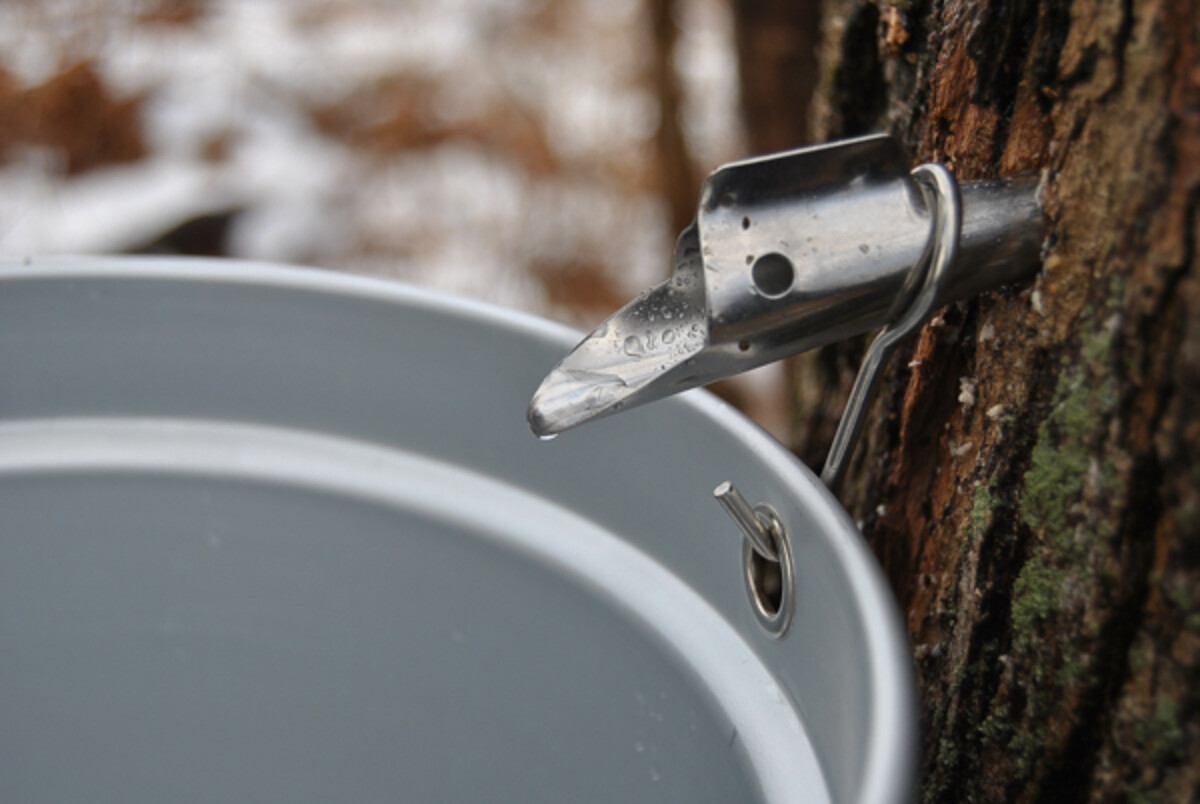
Tapping Maple Trees for Syrup (Acer Species)
There are 10 different species of maple trees that can be tapped for syrup. Each produces a syrup with a slightly different flavor profile. The differences are subtle, and the species has less to do with the final flavor than other seasonal and local factors.
Regardless of the maple species, the syrup flavor will be determined largely by your unique climate, the weather that year, and the time of the season when it was boiled (early v. late season). That means that no two maple syrups are exactly alike, each has its own unique qualities in much the same way that regionally specific fine wines boast.
For the most part, commercial sugar makers only use densely planted sugar maple stands for syrup production. At home, feel free to experiment with any of these 10 syrup-producing maple species.
Sugar Maples (Acer saccharum)
Sugar maples are by far the first choice for use in maple syrup production. They have the highest sugar content, the best yield and the longest sugaring season. On average, sugar maples will produce for 20 days across a 6 week season and produce roughly one quart of syrup for each tree tapped.
Black Maples (Acer nigrum)
Commonly confused with sugar maples, black maples produce a very similar sap. It’s nearly as sweet, and the trees produce at about the same time. Black maples have a more limited range and are found further west throughout Illinois and the great lakes states.
Red Maple (Acer rubrum)
Unless you’ve marked trees in the fall, it can be hard to tell the difference between a red maple and a sugar maple. Red maples have a high sugar content in their sap, but not quite as high as sugar maples. It’s reported to be roughly 1.5 – 2% sugar (as compared to 2% to 2.5% for sugar and black maples).
Red maples tend to grow on wet and waterlogged soils that are marginal for sugar maples, so they are used for maple syrup production in a pinch.
Unfortunately, red maples tend to break bud early in the spring, cutting the sugaring season short. Once a tree “breaks bud” or begins to leaf in, the sap begins to take on a “grassy” taste and is less desirable. Sugar makers consider this “green” syrup inferior, but it’s still perfectly fine for home use.
Silver Maple (Acer saccharinum)
Silver maples are a particularly beautiful tree, with leaves that are pointier in shape than the large maple hands on sugar maple trees. The leaves also take on a silvery hue as they’re blown in the wind.
Like red maples, silver maples tend to leaf early in the spring, cutting the sugaring season short. Take care to stop tapping as they begin to break bud to avoid grassy syrup.
Silver maples also have a lower sugar content, rated at roughly 1.7% sugar in the sap on average (as compared to 2% to 2.5% in sugar maples). Yields will be lower, and the finished syrup is a bit lighter colored and thinner.
Beyond that, silver maples produce a lot of “sugar sand” which is excess minerals that need to be filtered out of the final syrup. When we make syrup, we don’t filter it. We let it settle to the bottom of the jar and then I eat it with a spoon or on toast.
It’s delicious, and I tell myself that it’s a great way to get my minerals. Nonetheless, it clogs up the works in commercial operations, making silver maple the 4th choice, well behind the three listed above.
Norway Maple (Acer platanoides)
The sap of Norway maples is not quite as sweet as sugar maples, but the tree is quite common in some areas. It’s actually considered invasive by some since it tolerates conditions normal maples cant handle. The taste is quite similar to sugar maple syrup.
Boxelder (Acer negundo)
Boxelders are a small scrubby form of maple that is heavily used in northern Canada where land is marginal and prime trees are less available. While it takes roughly 40 gallons of sugar maple sap to make a gallon of maple syrup, box elder sap takes 60 or more gallons to boil into a gallon of syrup due to its lower sugar content.
Since they’re generally small, each tree also produces less than a large sugar maple. For the most part, they’re only used for syrup if the land is unsuitable for anything else. The syrup tends to taste a bit like sorghum syrup, so it’s not quite that same mapley flavor you’re used to.
Bigleaf Maple (Acer Macrophyllum)
Bigleaf maple is a maple species used for syrup in the pacific northwest, all the way from Alaska down through California. Keep in mind that though it grows out west, to produce syrup you’ll need nights below freezing and daytime temperatures around 40 degrees. That’s not common across the range of bigleaf maple south of Alaska.
Bigtooth Maple (Acer grandidentatum)
Native to the interior of the United States, mostly out west, bigtooth maple is very similar to sugar maple. Yields are somewhat lower, and again, keep in mind this tree will only produce with freezing overnight temperatures and daytime highs in the ’40s.
Rocky Mountain Maple (Acer glabrum)
Rocky Mountain Maple is another maple species native to Western North America. Though technically tappable, spring temperatures are not often right for a sap run.
Gorosoe (Acer mono)
Gorosoe is a species of maple tapped in Korea. This tree has been tapped for its sap for millennia, though the sap is not generally cooked down into syrup. The people of South Korea drink the sap for its health benefits.
According to the New York Times, Korean people are said to go on sap drinking binges, consuming gallons in a day in a hot room. The theory is to sweat out the bad stuff and replace it with health-giving maple sap.
Gorosoe sap is mildly sweet and tastes a bit like weak green tea.
In Korea, the uncooked sap sells for about $7 per gallon. That actually works out to be much more expensive than sap cooked into syrup in the states. Though you can cook Gorosoe sap into syrup, that’s not how it’s traditionally consumed.
In North America, tree sap is becoming a popular spring beverage, and a few producers are even canning it up as fresh maple seltzer (just sap and carbonation). One of my blogger friends writes about the benefits of consuming fresh sap here: Tree Sap: Natures Spring Tonic.
Tapping Birch Trees for Syrup (Betula Species)
Birch syrup has been used by traditional peoples in what is now Norway and Sweden since long before the discovery of the new world. It’s just starting to be commercially produced throughout the world, with several producers in the United States selling it at high prices.
Birch syrup requires more energy to produce, as it takes 110 gallons of cooked down sap to make a single gallon of birch syrup, as compared to 40 gallons of sap for traditional maple syrup. These days, some maple syrup producers are adding birch syrup on as a sideline.
Birch trees produce a bit later than maple trees. They require daytime temperatures in the ’40s and ’50s and often produce in April just as maple trees are finishing their sap run.
Birch trees only produce for about 2 weeks, so it can be a quick way to get a last little bit of syrup made before you put away your tapping gear for the year. In 2018, maples began producing on our land in late February, and birch trees didn’t start flowing until late April.
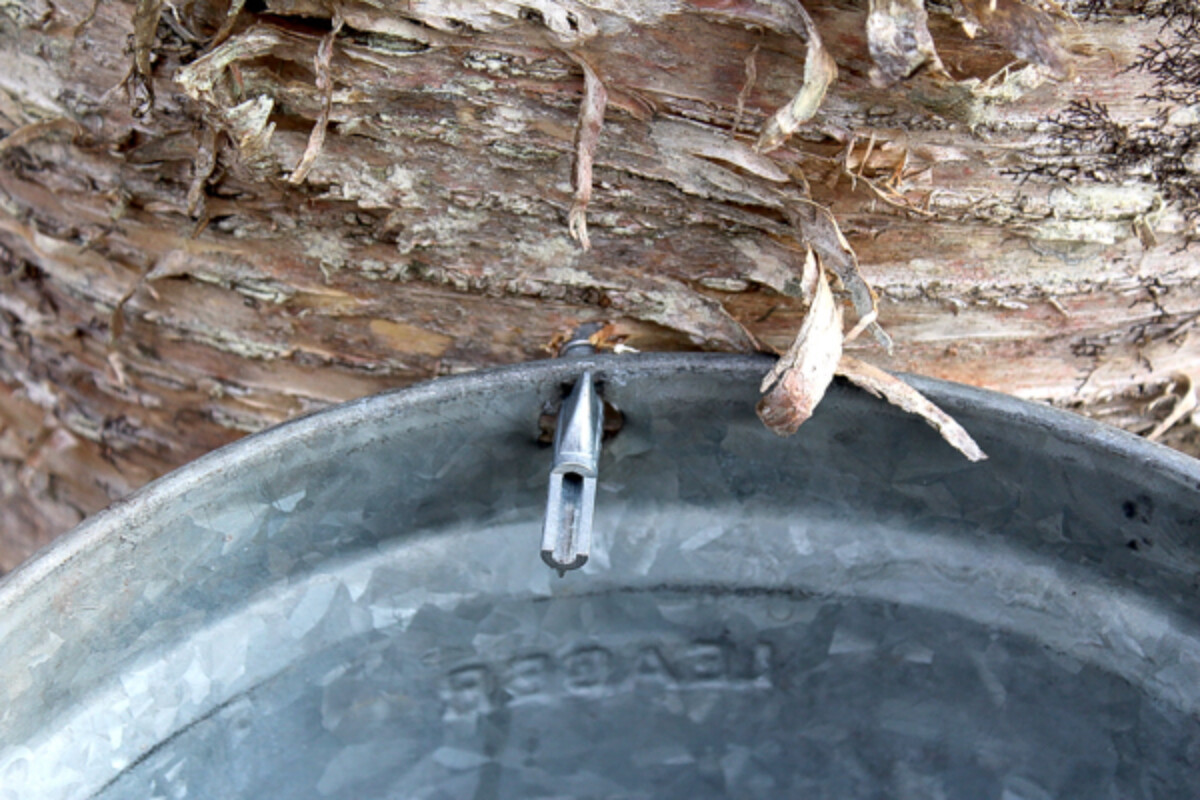
Still, its high price tag along with its delicious distinctive flavor are good reasons to try producing your own at home. Retailers are currently selling syrup for an average of $25 for an 8 oz bottle, or the equivalent of $400 per gallon.
Traditionally, birch syrup was used as a sweetener, made into vinegar, fermented into liquors, wines and ales, as well as having uses in traditional medicine. It’s reported to have been used for ailments ranging from topical rashes to scurvy.
Birch sap is more acidic than maple sap, and it has a tendency to eat away at traditional maple sap buckets. These days, producers use plastic tubing and spouts, and historically it would have been collected using sumac or elderberry taps, into bark or wood buckets.
If you’re considering tapping birch trees, here’s a tutorial I wrote up when we made our first birch syrup.

Paper Birch (Betula papyrifera)
Paper birch has the highest sugar content of all the birches and is considered the best for commercial tapping. Still, the sugar content is less than 1% on average, and it takes almost 3 times as much paper birch sap to make a gallon of syrup as it does for maple.
Yellow Birch (Betula alleghaniensis)
Studies have shown that yellow birch contains the highest levels of antioxidants, making it desirable for syrup production. Some Canadian producers are selling specially made yellow birch syrup for this reason.
It has a lower sugar content than paper birch, and it breaks bud early, meaning a very short season (less than 2 weeks). This makes yellow birch syrup hard to come by, but the finished syrup has a pronounced caramel flavor.
Black Birch (Betula lenta)
Black birch is a variety that is traditionally used and is often fermented into beer.
River Birch
This birch species is common in the Southeastern United States, and it has been planted as an ornamental tree in other regions. Though production is marginal, river birch will make syrup.
Gray Birch
Likewise, gray birch can make syrup, but only in a pinch. It’s more of a shrub than a tree, and it rarely grows large enough to be worth the effort.
European White Birch
A cousin to the American White Birch, European white birch can be used successfully for making birch syrup.
Tapping Alder Trees for Syrup (Alnus Genus)
The pacific northwest lacks sugar maples, but it doesn’t lack ingenuity. I’ve found countless references to tapping alder trees, and it makes a lot of sense.
They’re in the birch family, but they split off into another genus (Alnus). They’re closely related cousins, so it follows that they’d have similar sap properties.
Forum comments make it sound like the syrup is “spicy” and that scares people a bit. Birch syrup is also a bit spicy, and that’s what I love about it.
I finally found a reference from Mother Earth News to tapping alder, alongside birch and bigleaf maple. The article is written by someone who taps them regularly, so I’d give it credence.
Tapping Nut Trees for Syrup (Juglans Species)
Nut trees in the walnut family all produce high sugar sap that can be boiled into excellent syrup. The sugar content and timing are similar to that of maples. Nut trees are some of the last to break bud in the spring, so they’ll keep producing usable sap long after maples have finished.
Though the season is longer, they actually produce far less sap, only about 1/3 as much per tree as maples. That means that you’ll need to tap more trees to get the same amount of finished syrup.
Trees in the walnut family grow wild in many parts of the country, especially areas where maples are not common. That makes them especially valuable for tapping.
Black Walnut (Juglans nigra)
Black walnut syrup has a unique, light and refreshing taste that’s nothing like the tanning-filled nuts they produce in the fall. A friend of mine taps black walnut trees in Missouri each year.
Just like with maple trees, the season varies dramatically with the weather. They’ve tapped as early as January and as late as March.
Butternut (Juglans cinerea)
Butternuts are said to produce a smooth, light syrup. Around these parts, we may never know. In the last few decades, the native butternuts have been devastated by butternut canker, and we’ve seen tree after tree come down.
The canker weakens the wood and eventually kills the whole tree. There’s only 1 butternut left standing on our land, with a sad 10 or so leaves. It’s not long for this world.
If you find a true butternut, do it a favor and cherish it. I’m sure the syrup is delicious, but leave that beautiful tree alone.
Heartnut (Juglans ailantifolia)
Heartnuts are the Japanese version of an English walnut, and they’ve been naturalized to the states. Just like all trees in the Juglans family, they can be tapped for syrup.
Buartnut (Juglans xbixbyi)
Buartnuts are a cross between butternuts and heartnuts that seems to be resistant to the butternut canker! They produce a delicious buttery nut, from hearty trees that can be grown as far north as zone 4.
They’re showing great promise to replace the native butternuts in the forest ecosystem. Tap away my friends, and save a butternut.
English Walnut (Juglans regia)
Though English walnuts can be tapped for syrup, they generally grow in warm regions that don’t have good spring weather for tapping. There are a few hearty varieties being developed for the northeast, so perhaps soon there will be a thriving English walnut and walnut syrup market for us here in Vermont.
Tapping Sycamore Trees for Syrup (Platanus occidentalis)
Sycamore sap has a lower sugar content than maple, so it’ll take quite a bit more sap to make a reasonable amount of syrup. They’re very common landscape trees, and so odds are you have a few in your neighborhood.
Even if you only have a few, the sap can be mixed in with the sap of other tappable trees. Sycamore syrup has a distinctive butterscotch flavor, and even added to other sap in small quantities, it’ll give you a unique finished syrup.
Outdoor life writes about making sycamore syrup but they state that the yield is the same as maple. The article is a bit sparse on information, so I’m left to wonder if they were actually successful in the end.
Tapping Linden Trees for Syrup (Tilia americana)
The sap of linden trees (basswood) is said to have a very low sugar content. The trees tend to grow where water is abundant, and as a result, have very watery sap.
This spring I intend to find out. Most mentions of tapping basswood trees say that there’s not enough sugar in the sap to bother with boiling, but those same sites dismiss birch syrup just as easily.
It’s good to note that young basswood saplings have a pithy center, can be cut and bored out for use as tree taps. Alongside sumac and elderberry spiles, that could come in handy if you’re hoping to make your own homemade taps.
Most parts of linden trees are edible or at least useful in some way, and though I’ve yet to tap one, they’re worth having around for their tasty leaves and blossoms.
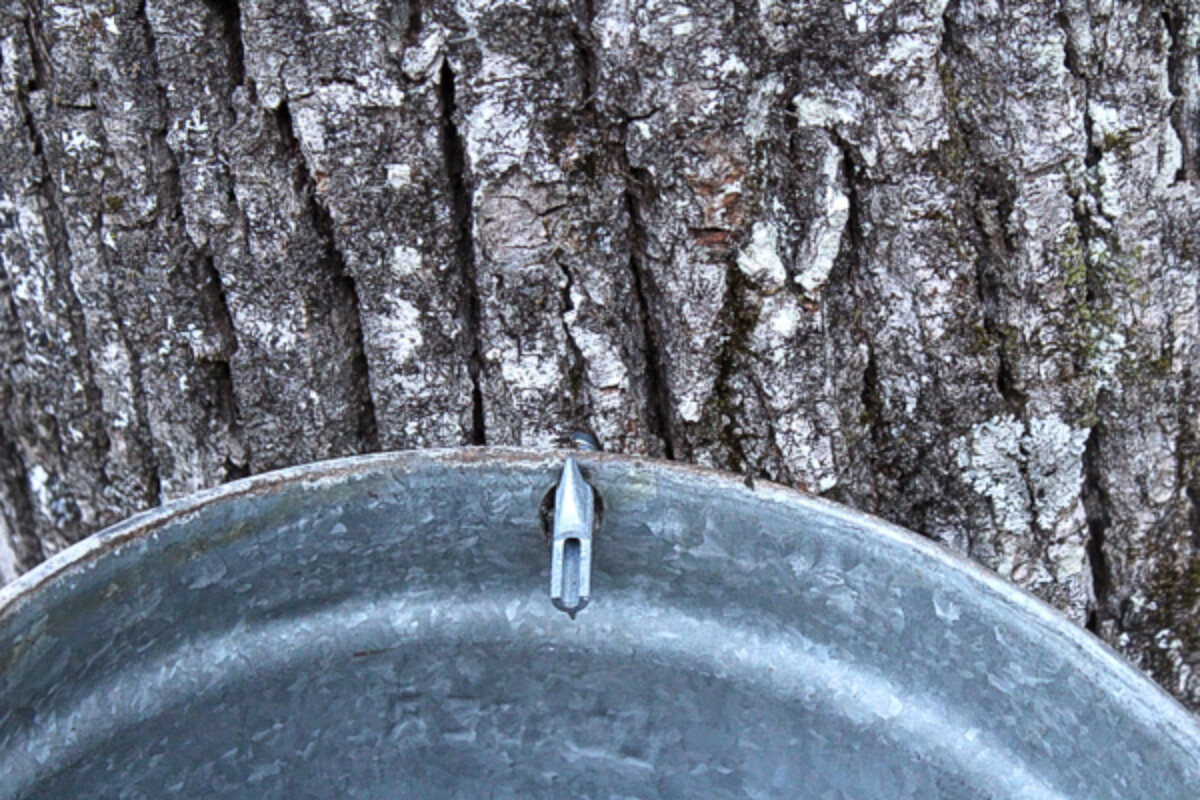
Tapping Ironwood Trees for Syrup (Ostrya virginiana)
Ironwood trees are considered a weed tree by foresters since they readily grow in the understory and can outcompete more marketable species in low light. Our woods are full of them, and though I don’t consider them a weed, they are prolific.
They produce sap much later than maples and start running about a week after birch trees. We found boiling 2 gallons of sap yielded about 4 ounces of syrup, which is not quite as good as maples, but much better than birches.
The syrup was quite bitter and had a slight tannin taste. I wrote up our experience tapping ironwood trees if you’re curious.
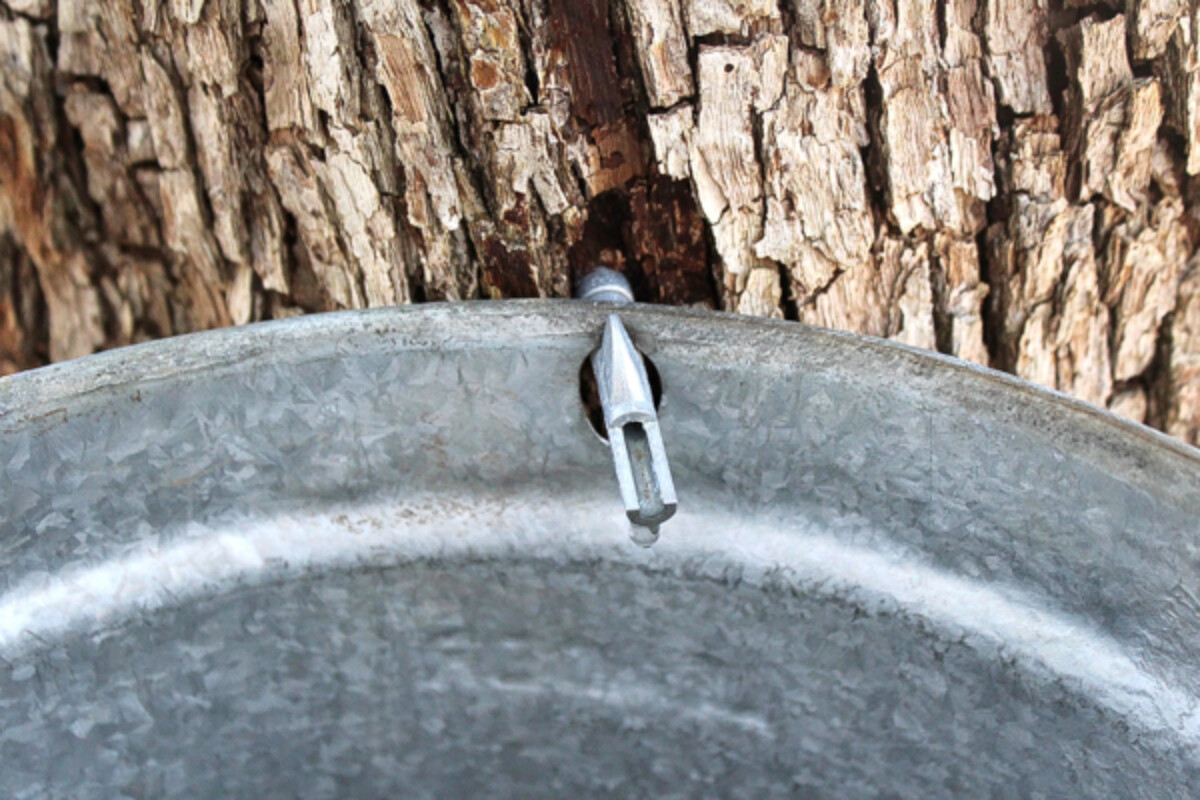
Tapping Hickory Trees for Syrup (Carya genus)
Hickory trees can be tapped for syrup, but these days that’s not how “hickory syrup” is made. A producer called Wildwoods Syrup is selling hickory syrup commercially and produces more than 30,000 bottles annually.
Their product is “wild foraged,” but it’s made by boiling hickory bark to extract its flavor and then adding cane sugar. Though it does produce an interesting smokey and woodsy flavor, it’s not from tapped hickories.
I know that it sounds weird, but homemade shagbark hickory syrup is absolutely amazing, and everyone in my family loves it. It’s a simple recipe, and all you need is a bit of sugar and the bark,, which the tree sheds naturally.
I have yet to find anyone who can tell me if there’s a difference between actually tapped hickory syrup, and boiled hickory bark and sugar. I’m also not sure if tapping hickory trees actually works, as I haven’t found anyone who has tried it. If you have shagbark hickories to tap, give it a try and let me know how it goes.
(We forage the bark from trees on public land…but I can’t tap those.)
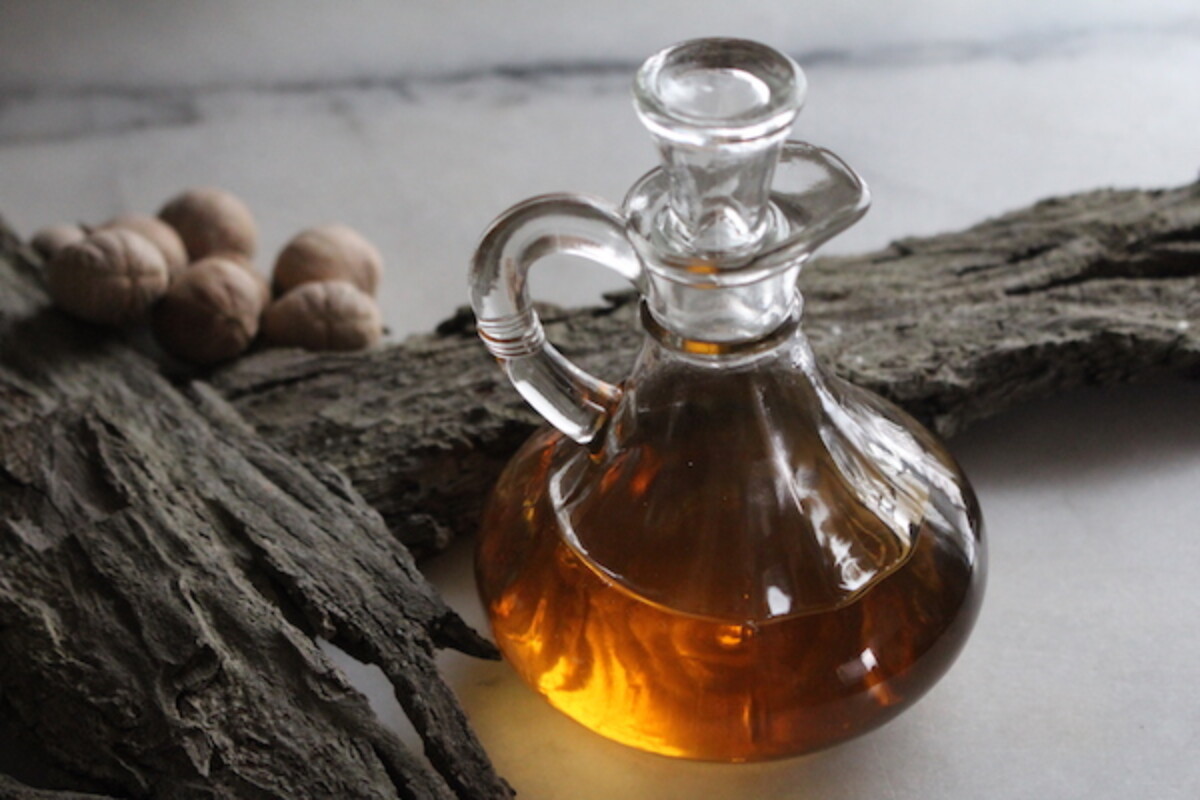
Tapping Elm Trees for Syrup (Ulmus genus)
Though supposedly tappable, and listed as a syrup tree even by county extension agents, Elms have their own problems. Dutch elm disease is destroying elm trees by the millions, and adding to that stress by puncturing the bark and potentially contaminating healthy trees, is just irresponsible.
I’d class these as the same as butternuts. They’re supposed to make good syrup but stick to more responsible choices.
Making Palm Syrup (Coconut Palm and other palm species)
But you don’t have to live in northern, temperate climates to have access to tappable trees. The Asian sugar palm, for example, not only contains more sap than a typical maple tree, its sap contains up to five times as much sugar (sucrose).
Add to that the fact that it can be extracted for fully half the year, not just during a six-week early spring “sap run”, and you’ve got a seriously high-producing sugar tree.
Some Asian palms are capable of delivering 20 or more liters of their super-sugary sap in a single day. Compare that to even the highest producing maple tree, which can at best yield eight.
Other sugar-producing tropical trees include oil palms, date palms, and coconut palms. All produce more sugar and in greater quantities than maple trees.
Where can you find these syrups? Usually in health food stores, or online where they’ll label as “palm honey” or “coconut palm syrup.” It’s marketed as a low glycemic alternative to sugar, in much the same way as agave nectar.
Alton Brown’s blog, Serious Eats, calls Palm Syrup the maple syrup of southeast Asia:
“Maple syrup—and, to a lesser extent, honey and agave—may be the boutique sweetener in the U.S., but it’s all about palm sugar in Southeast Asia. Particularly in Malaysia and Indonesia, you’ll find some of the best tasting sugar around, made with the care and attention granted to fine wine. Rather than a single product, this is a whole class of sugars; different regions use different palms, extraction methods, and local terroir to create distinct and unique products. (Serious Eats)”
Other Tree Species to Tap
In theory, just about any deciduous tree can be tapped in the spring. They all should produce some amount of sap as the freeze-thaw cycle brings sap up to the buds in spring. The above list is based on credible references or my own experience.
I also found references to tapping a number of other trees, but I’m skeptical about these claims:
Poplar Trees – One reference mentions tapping poplar trees, but there are a number of other factual errors in the post that leave me skeptical. They don’t seem to have actually tried it.
Poplar trees are used to make Balm of Gilead, which leads me to believe their sap is gummy and resinous. If you have experience, leave it in the comments below.
Wild Burlington, an outdoor education group based in Vermont, mentions tapping the following trees as an experiment in one of their classes. They followed up to say that they were not very successful, but they believe they just tapped too late in the season.
They also note that the sap of black locust, smoke tree, staghorn sumac and buckthorn are toxic and should not be tapped for syrup. They tapped them as part of an experiment to see how much sap would flow:
- White ash (Fraxinus americana)
- Apple (Malus domesticus)
- Big-toothed Aspen (Populus grandidentata)
- Black Cherry (Prunus serotina)
- Hackberry (Celtis occidentalis)
- European larch (Larix decidua)
- Red Oak (Quercus rubra)
- Black Locus (Robinia pseudo-acacia) – Potentially toxic, do not tap.
- Smoke tree (Cotinus sp.) – Potentially toxic, do not tap.
- Staghorn sumac (Rhus typhina) – Potentially toxic, do not tap.
- Buckthorn (Rhamnus cathartica) – Potentially toxic, do not tap.
If you’re planning on experimenting with tapping new tree species, first and foremost, make sure it’s not toxic. Also, be sure that it’s not a threatened species like butternut or elm. Stick to deciduous trees, those that lose their leaves in winter.
Pines can be “tapped” but the sap is not used for syrup, but instead glue and turpentine. I did find one reference to “sugar pine” and the article noted that “John Muir found its sweet resin preferable to maple sugar (Source)” but that was chewing resin, not syrup made from sap.
I’d love to hear if you have experience tapping anything other than maple. Post links or stories in the comments below to add it to this repository of knowledge.

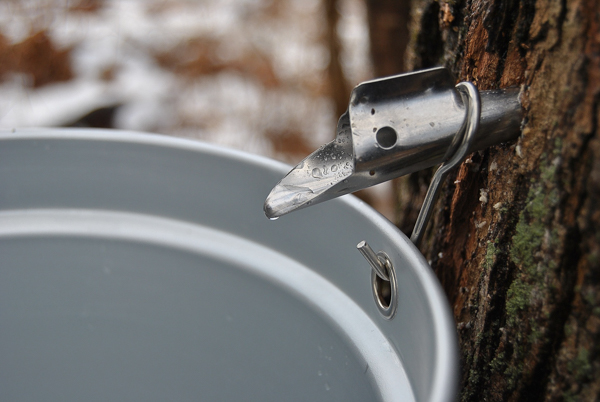

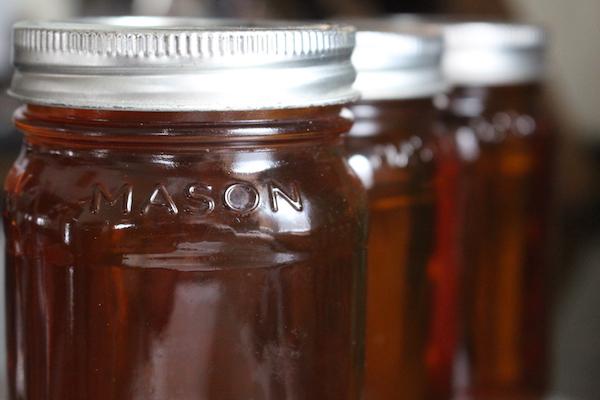
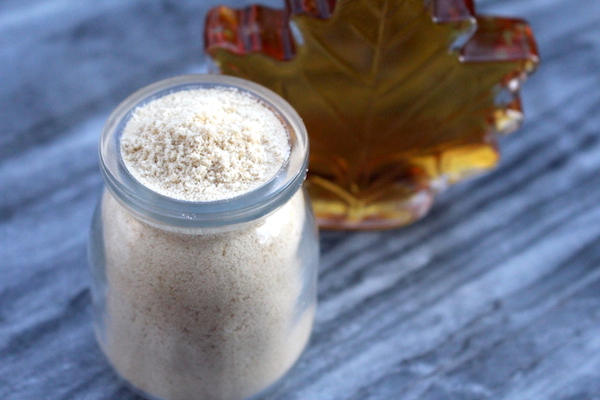










We don’t have any shagbark hickory trees in our area but I have a lot of other hickorys all around my house. I’ve learned that I can make a delicious hickory syrup from the nuts, and a few roasted twigs. The hickory nuts don’t even need to be shelled! I simply remove the outer husk, check the shells for weevil holes, drop them in a tub of water (if they float they probably aren’t viable and go back to the squirrels), use a large flat rock and smack them with my small sledge hammer. Then put the nuts, she’ll and all in a large pot. Toss in three or four fresh hickory twigs that have been toasted. Cover with fresh water and simmer until the fragrance of hickory fills the air and the water is a nice tan color. Then I filter through a strainer lined with cheesecloth. Frequently, the nutmeats will have separated from the shells and I’m able to skim out several cups of clean hickory nut meat that can be toasted and then used in baking. The hickory water is then put back on to simmer with granulated sugar until it reduces down to the thickness of syrup and poured into jars for a quick water bath to can. I can’t keep enough made to keep all my friends and family supplied with as much as they want! It is a wonderful basting sauce for smoking too.
Excellent information in this, as well as, all of your the posts (articles). We are new farmers ( homesteaders) and It seems that my wife and I have missed the tree tapping season, again. But with a newly felled old Shagbark Hickory, on our 120 acres, we will process the bark and make the shagbark hickory syrup that you so kindly have shared.
Thank you,
Jay Rubino
Reynoldsville, WV
Wonderful! If you have a whole tree that’s a lot of potential syrup. Besides syrup, you can also dry the bark in the oven or dehydrator and use it for seasoning other things. It’s really good if you add a few pieces to braised meats, and it also makes a nice extract (in alcohol, like making vanilla extract). Or put a few pieces into a jar of white sugar and it’ll infuse the flavor into the sugar in a few weeks on the shelf. Enjoy!
This past winter did not produce a lot of sap in trees, but my sweetheart and I tapped a couple of silver maples and a black walnut. We did not get enough sap to make sellable syrup, but the saps combined made a very nice sweet liquid which I used to sweeten dandelion root tea for my foraging group. It was just right. Walnut sap is richer in flavor than maple and the combination was much to my liking and that of participants in the group.
What about bass wood or dog wood ? Can they be tapped ?
Basswood goes by the name Linden in some parts of the country, and yes, that can be tapped. I’m not sure about dogwood, it’s always a shrub here in Vermont rather than a tree.
This year 2024 was bad for up tapping our black walnuts we hardly got any compared to last yr but that’s fine. My question is that this yr even with the cold ants found my bucket. Didn’t happen last yr, but word got out this yr. Sowhat can I do to prevent that. They were right by the taps and in the buckets.
Any help would be appreciated.thanks
Most people just filter them out. You could also try attaching some type of screen over the top of the bucket to keep them out.
This year was much much better. No ants. Oddly they must have known my black walnuts weren’t going to give me anything. This year no ants lots of sap. ❤️
I’m getting really jealous. We used to have tons of wild mulberry in north Alabama. Now I’m in search of just one. Sycamore? I have to try it if I can avoid that cough producing pollen. Manchineel if I recall is toxic but was once consumed by native warriors going into battle so they hallucinated and had no fear. Lol- I fed our cows morning glory that was overtaking the garden. I didn’t know at the time. Figured cows had more common sense than humans and ate only what they could. Cows hallucinating was quite funny and sad at the same time. Hackberry? I’ll stop cutting them off my property if so. As for those on the walnut kick. And info, I got lucky and bought 3 gallons walnut oil at the dig store for $3. It’s awesome and my daughter allergic to almost any tree had no issues. For the one asking about willow tapping. It’s good for water in a pinch. Avoid too much as it (can)acts as a blood thinner and pain reliever…natures aspirin. No no no to the one asking about pine. It tastes and is turpentine. Although, you can scrape the cambium layer off and roast it over a campfire for some unique tasty citrus like potato cups that have enough fiber to stop c-diff You can nibble on the pollen tips if you need the vitamin c-it still taste turpentinish (my word). Anyone tried tapping redbuds? I love to mix the flowers on salad with violets and violet leaves and dandelion yellows. Sorry to be tangential in my post. Still feeling jealous of all you professional tappers and all the flavors you guys get to explore. Again-bring me some new syrups to Alabama and I’ll take you on a fishing expedition with a promise of a year supply of fish. I might even clean them for you.
Have you tapped Mulberry for syrup? They grow like crazy here in Nebraska. Elm does as well. I found a metal tap at a second hand shop so maybe next year I will give it a go.
I haven’t tapped mulberry, but that’s an interesting one! We only have a few small mulberries I’ve found around here, nothing in tappable size. Let me know how it goes!
I’d make several quarts of hickory syrup for a chance to eat some fresh fish!!
Enjoy the arrival and comments. I first must address a safety issue I noticed. Buckeyes are extremely toxic and even kill our cattle by ingesting the partials into their lungs. Anyone tapping a buckeye can likely no longer respond to this post. Some other species such as Apple have milder toxins mostly concentrated in the seed. But I suspect like the seed you would die of a belly ache to eat enough to die from the toxin. Don’t eat Polk stalks after they turn purple. Only eat elderberry when very purple. Eat as many purple violets as you please. (Makes the best jelly). Now, I’m on an adventure to try everything God has to offer, preferably kosher (no I’m not Jewish nor Muslim). But my goal is to have sampled every taste of nature within safe reason. I’ll try to let y’all know my findings on the taps. We have plenty elm. Butternuts are getting scarce. I’m thinking ash might be worth a tap since the nut is as underutilized as the maple nut. People might also want to consider allergies. Rub some pecan or walnut sap on your skin and if it itches or inflamed, you might avoid introducing it to the gut, unless constipation is a problem. Wish we had birch in Alabama. I’d swap a few pounds of crappie or catfish for a few gallons.
Great article and breakdown. We have many types of oaks here in south Louisiana and also Pecans. I see Nut tress are good so i’d like to try Pecan next year, because too close to spring now. We have sycamore also so I will definitively try that next season. I was wondering about the Camphor tree? they grow like crazy here with dozens of new tress popping up through the spring. It’s one of the most highly producing sap trees here that i know of besides the pine tree. I also know that the sap has MANY and multiple medicinal uses. Oh, yeah,,, and mulberry grows like crazy and spreads here also with trees popping up in my yard each spring. I will definitely try the sycamore and the mulberry but would really like to know about the camphor since it’s such an abundant sap producer.
I don’t have any information on the camphor tree but I’m interested to know how it works out for you if you decide to try it.
I live in northern Alberta and I tap Manitoba maples. They also give a 40 / 1 ratio. I harvest when it’s above freezing during the day and below at night. The syrup is a light golden color, very sweet and a bit smokey from my fire. It doesn’t taste like sugar maple syrup but is delicious. I usually freeze my pails of sap till I’m ready to boil it all, but I like the idea of half freezing and removing ice.
I have tried to tap both white and black poplar but have not got even one drop. I might try it one more time using different methods like trees in full sun light etc.The black poplar produces very sappy buds in the spring (late March) which I pick, usually about a quart and cover with olive oil. About mid summer or so I strain this and use it on sore joints and scrapes and cuts for pain relief.
For those wanting to use evergreens look up Mugolio syrup. It is 4 cups of sliced up green cones with 4 cups of brown sugar or honey, let it stand a month or so and strain. This is my project for this year. It’s supposed to be delicious.
Thank you so much for sharing.
Another tree to avoid tapping is the Manchineel (Hippomane Maneinella) [aka Beach Apple or in Spanish Manzanilla de la Muerte (Little Apple of Death]. It is native to the Caribbean area including Florida. This is considered to be one of the most toxic trees in the World.
it is
Poplar can be tapped, but it is one that (like birch and aspens) many people are allergic to, so it’s not a common choice for it. Balm of Gilead is not made with sap but is an oil extract made with the spring buds.
I have been tapping black walnuts and maple for a few years now. Never thought to try my river birches! I’ll need to measure them and see if any are tappable (though I’m guessing though as they are pretty small still). I have been trying for years to find out for sure about hackberry trees though. It’s on the list of possibles, but no definitive answers. I read in a forum once of someone overbearing two older men talking about heresay of tapping hackberries. They make such sweet little berries, that I do wonder! But then, it could have been that the heater overheard them speaking of “syrup” from the hackberries, which certainly would be doable. Guess there’s only one way to find out about the tapping though. If I’m up for it this year, I’ll report back. 😅😅😅
Sounds great! Keep us posted.
I have a lot of black walnuts and in speaking with a friend that taps her maples, she said black walnut syrup would bring in a lot of money because she gets asked for it all the time. I bought my tap set but once I learned how much it requires, I bought more sets so I could do the process all at one time. So if you get a chance and are really into tapping…look for black walnuts!
I have always wanted to make my own maple syrup and have been considering tapping the maple in my front yard. After looking up how to do it, I have become intrigued with making syrup from other trees. I have a several black walnut trees but I am allergic to tree nuts. Do you think I would have a reaction to the sap also? If you don’t know, do you know where I might find the answer?
Apparently there was a study done at the Cincinnati Children’s hospital regarding walnut allergies. They found that children who tested positive for walnut allergies did not react to skin testing or oral testing with walnut syrup. You might want to do a bit more research before testing it but it definitely sounds promising.
I have a niece with a walnut allergy and she did not react to my walnut syrup. I will note that she only had a mild allergy (I don’t think she required epipens, for example, but I’m not for sure).
What sort of native species have people tapped? In my neck of the woods, black willow is certainly large enough, but is willow sap bitter or inedible?
What about boiling down to a target gravity and fermenting straight away? Acerglyn is delicious so I’d think sap boiled to the right concentration could save you some boiling, albeit yield a different product in the end.
FWIW I have heard that some intentionally tap oaks for tannic value and blend it as a portion of their sap when they make a run